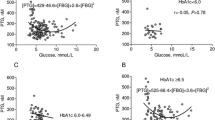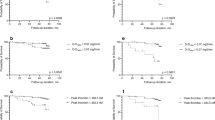Abstract
Plasma TAFI may participate in arterial thrombosis in cardiovascular diseases (CVD) and may be involved in the mechanism of vascular endothelial damage in diabetic patients. The aim of this study was to investigate the association of plasma TAFI antigen level in the development of diabetic foot ulcer in Type 2 diabetes. The TAFI antigen levels were determined in 50 patients with diabetic foot ulcers and 34 patients without diabetic foot ulcers and 25 healthy individuals. We measured TAFIa/ai antigen in plasma samples with a commercially available ELISA Kit. Diabetic foot ulcer group and diabetic group were similar in terms of mean age and sex distribution. Diabetes duration, retinopathy, neuropathy, macrovascular disease and infection were related to diabetic foot ulcers. HbA1c, HDL-cholesterol and Folic Acid levels were decreased in the diabetic foot ulcer group. TAFI levels were 99.44 ± 55.94% in control group, 135.21 ± 61.05% in diabetic foot ulcer group, 136.75 ± 59.38% in diabetic group and was statistically different (P < 0.05). But no difference was seen in TAFI levels between the diabetic foot ulcer group and diabetic group (P > 0.05). No significant difference in plasma TAFI levels were seen between diabetic foot ulcer stages. TAFI antigen levels are increased in Type 2 diabetic patients, but are not related to diabetic foot ulcer development.

Similar content being viewed by others
References
J.L. Richard, S. Schuldiner, Epidemiology of diabetic foot problems. Rev. Med. Interne 29(Suppl 2), S222–S230 (2008)
D. Malgrange, Physiopathology of the diabetic foot. Rev. Med. Interne 29(Suppl 2), S231–S237 (2008)
C. Figueroa-Romero, M. Sadidi, E.L. Feldman, Mechanisms of disease: the oxidative stress theory of diabetic neuropathy. Rev. Endocr. Metab. Disord. 9(4), 301–314 (2008)
J. Martini, Diabetic foot: detection and prevention. Rev. Med. Interne 29(Suppl 2), S260–S263 (2008)
I. Got, Peripheral vascular disease and diabetic foot. Rev. Med. Interne 29(Suppl 2), S249–S259 (2008)
Bader MS. Diabetic foot infection. Am. Fam. Phys. 78(1):71–79 (2008) (review)
E. Senneville, Infection and diabetic foot. Rev. Med. Interne 29(Suppl 2), S243–S248 (2008)
D.L. Eaton, B.E. Malloy, S.P. Tsai, Isolation, molecular cloning, partial characterization of a novel carboxypeptidase B from human plasma. J Biochem Chem 266, 21833–21838 (1991)
L. Bajzar, R. Manuel, M.E. Nesheim, Purification and characterization of TAFI, a thrombin-activatable fibrinolysis inhibitor. J Biol Chem 270, 14477 (1995)
L. Bajzar, M.E. Nesheim, P.B. Tracy, The profibrinolytic effect of activated protein C in clots formed from plasma is TAFI dependent. Blood 88, 2093–2100 (1996)
C. Erem, A. Hacihasanoglu, S. Celik, E. Ovali, H.O. Ersoz, K. Ukinc, O. Deger, M. Telatar, Coagulation and fibrinolysis parameters in Type 2 diabetic patients with and without diabetic vascular complications. Med. Princ. Pract. 14, 22–30 (2005)
Y.T. Kruszynska, J.G. Yu, J.M. Olefsky, B.E. Sobel, Effects of troglitazone on blood concentrations of plasminogen activator inhibitor 1 in patients with type 2 diabetes and in lean and obese normal subjects. Diabetes 49, 633–639 (2000)
A. Hamsten, U. de Faire, G. Walldius, G. Dahlén, A. Szamosi, C. Landou, M. Blombäck, B. Wiman, Plasminogen activator inhibitor in plasma: risk factor for recurrent myocardial infarction. Lancet 8549, 3–9 (1987)
Y. Hori, E.C. Gabazza, Y. Yano, A. Katsuki, K. Suzuki, Y. Adachi, Y. Sumida, Insulin resistance is associated with increased circulating levels of thrombin-activatable fibrinolysis inhibitor in type 2 diabetic patients, J. Clin. Endocrinol. Metab. 87, 660–665 (2002)
H. Aubert, C. Frere, M.F. Aillaud, P.E. Morange, I. Juhan-Vague, M.C. Alessi, Weak and nonindependent association between plasma TAFI antigen levels and the insulin resistance syndrome. J. Thromb. Haemost. 1, 791–797 (2003)
A.I. Adler, E.J. Boyko, J.H. Ahroni, D.G. Smith, Lower-extremity amputation in diabetes. the ındependent effects of peripheral vascular disease, sensory neuropathy, and foot ulcers. Diabetes Care 22, 1029–1035 (1999)
S.O. Oyibo, E.B. Jude, I. Tarawneh, H.C. Nquyen, L.B. Harkless et al., A comparison of two diabetic foot ulcer classification systems: the Wagner and the University of Texas wound classification systems. Diabetes Care 24, 84–88 (2001)
L. Prompers, M. Huijberts, J. Apelqvist, E. Jude et al., High prevalence of ischemia, infection and serious comorbidity in patients with diabetic foot disease in Europe. Diabetologia 50, 18–25 (2007)
K.C. Tan, W.S. Chow, V.H. Ai, Y.L. Siow et al., Hyperhomocysteinemia and Impaired vasomotor Function in Type 2 diabetes mellitus. Eur. J. Clin. Investig. 32, 328–334 (2002)
M. Buysscheart, J. Jamart, A.S. Dramais, P. Wallemacq et al., Micro- and macrovascular complications and hyperhomocysteinemia in Type 1 diabetic patients. Diabetes Metab. 27, 655–659 (2001)
S.R. Kravitz, J. McGuire, S.D. Shanahan, Physical assessment of the diabetic foot. Adv. Skin Wound Care 16, 68–77 (2003)
W. Wang, M.B. Boffa, L. Bajzar et al., A study of the mechanism of inhibition of fibrinolysis by activated thrombinactivatable fibrinolysis inhibitor. J Biol Chem 273, 27176–27181 (1998)
Bentley J, Foster A. Multidisciplinary management of the diabetic foot ulcer. Br. J. Commun. Nurs. 12(12):S6, S8, S10 passim (2007)
M.P. Khanolkar, S.C. Bain, J.W. Stephens, The diabetic foot. QJM 101(9), 685–695 (2008). Epub 2008 Mar 18
Al-Maskari F, El-Sadig M. Prevalence of risk factors for diabetic foot complications. BMC Fam. Pract. 8:59 (2007)
R. Gary Sibbald, K.Y. Woo, The biology of chronic foot ulcers in persons with diabetes. Diabetes Metab. Res. Rev. 24(Suppl 1), S25–S30 (2008)
P.C. Leung, Diabetic foot ulcers—a comprehensive review. Surgeon 5(4), 219–231 (2007). review
C.A. Andersen, T.S. Roukis, The diabetic foot. Surg. Clin. North Am. 87(5), 1149–1177 (2007)
H.M. Rathur, A.J.M. Boulton, The diabetic foot. Clin. Dermatol. 25, 109–120 (2007)
G.W. Gibbons, The diabetic foot, in Principles and Practice of Endocrinology and Metabolism, ed. by K.L.Becker, 3rd edn. (A Walter Kluwer Company, Philadelphia, 2001), pp. 1435–1438
N. Papanas, E. Maltezos, Advances in treating the ischaemic diabetic foot. Curr. Vasc. Pharmacol. 6(1), 23–28 (2008)
A. Santamaria, A. Oliver, M. Borrell, J. Mateo, R. Belvis, J. Marti-Fabregas, R. Ortin, I. Tirado, J.C. Souto, J. Fontcuberta, Risk of ischemic stroke associated with functional thrombin-activatable fibrinolysis inhibitor plasma levels. Stroke 34(10), 2387–2391 (2003)
F.W. Leebeek, M.P. Goor, A.H. Guimaraes, G.J. Brouwers, M.P. Maat, D.W. Dippel, D.C. Rijken, High functional levels of thrombin-activatable fibrinolysis inhibitor are associated with an increased risk of first ischemic stroke. J. Thromb. Haemost. 3(10), 2211–2218 (2005)
A. Santamaria, A. Martinez-Rubio, M. Borrell et al., Risk of acute coronary artery disease associated with functional thrombin activatable fibrinolysis inhibitor plasma level. Haematologica 89(7), 880–881 (2004)
P. Lisowski, J. Malyszko, T. Hirnle et al., Thrombin activatable fibrinolysis inhibitor (TAFI) in stable angina pectoris patients undergoing coronary artery bypasses grafting (CABG). Rocz. Akad. Med. Bialymst. 50, 166–172 (2005)
D. Tschoepe, The activated megakaryocyte-platelet-system in vascular disease: focus on diabetes. Semin. Thromb. Hemost. 21(2), 152–160 (1995)
J. Małyszko, J.S. Małyszko, T. Hryszko, M. Myśliwiec, Thrombin activatable fibrinolysis inhibitor (TAFI) and markers of endothelial cell injury in dialyzed patients with diabetic nephropathy. Thromb. Haemost. 91(3), 480–486 (2004)
Y. Yano, N. Kitagawa, E.C. Gabazza, K. Morioka, H. Urakawa, T. Tanaka, A. Katsuki, R. Araki-Sasaki, Y. Hori, K. Nakatani, O. Taguchi, Y. Sumida, Y. Adachi, Increased plasma thrombin-activatable fibrinolysis inhibitor levels in normotensive type 2 diabetic patients with microalbuminuria. J. Clin. Endocrinol. Metab. 88(2), 736–741 (2003)
Author information
Authors and Affiliations
Corresponding author
Rights and permissions
About this article
Cite this article
Erdogan, M., Solmaz, S., Canataroglu, A. et al. Plasma thrombin-activatable fibrinolysis inhibitor (TAFI) antigen levels in diabetic foot ulcers. Endocr 37, 449–454 (2010). https://doi.org/10.1007/s12020-010-9329-1
Received:
Accepted:
Published:
Issue Date:
DOI: https://doi.org/10.1007/s12020-010-9329-1




